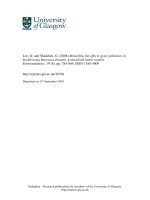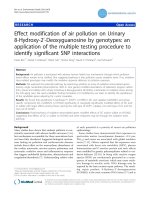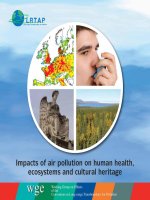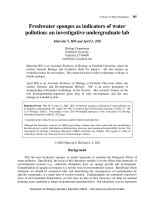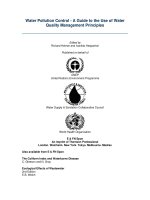Consequences of Water Pollution on Health ppt
Bạn đang xem bản rút gọn của tài liệu. Xem và tải ngay bản đầy đủ của tài liệu tại đây (155.63 KB, 9 trang )
Consequences of Water Pollution on Health
Samira Baba Hamed, Mansour Belhadri, Lila Benabdallah and Touria Gaouar
Laboratory of rheology, transport and treatment of the complex fluids
Hydraulics departement - University of Sciences and Technology – Mohamed Boudiaf -
Oran - Algeria
Abstract
Water is the source of life, but when badly exploited , it becomes a source of problems ; polluted, it
gives access to all diseases and opens doors to poverty, under development and becomes a cause of
death .
Water pollution has many sources. The most polluting of them are the city sewage and industrial
waste discharged into the rivers or sea. They can cause many illnesses that range from typhoid ,
dysentery, cholera , hepatitis A and skin diseases.
This study has been carried out in the town of Oran (west Algeria) , it gives an estimate of the
evolution of hydrous transmitted diseases these last decades. We will establish an assessment of
general situation and planning of the actions to be taken practical in front of epidemics diseases with
hydrous transmission.
We will propose a program which starts with the application of simple standards of hygiene and
extends on control of water points, the treatment of tanks and control the drinking water network.
The individual and the community can help minimize water pollution. By simple housekeeping and
management practices along with the reduction of the amount of waste generated.
Keys words : pollution – sewage – diseases - environment- prevention
Introduction
Water is the first spring and the determinant even of the life. Each part of water cycle would be an
ecosystem connected itself to the other watery ecosystems. So when the water drops fall towards the
ground, any substance dragged towards the ground becomes a water pollutant. Thus, pollution has
many origins which are connected to the water cycle. It can come directly from the human activities
like the discharge of waste or the chemical substances in water, or can be introduced anywhere into
the natural water cycle , or during its transfer from the collecting place to the consumer.
Water pollution is indissociable from the degradation of its vital qualities i.e. deterioration or
suppression of water potential functions.
The water intended for consumption can be contaminated following infiltrations or rejections. This
contamination results in the presence of toxic and polluting elements in levels that are out of
standards when it comes to drinking waters.
The origins of these infiltrations are numerous, inter alia the badly controlled rejections, which come
from certain industries and will end up joining a ground water, the infiltration of waste water network
into the drinking water network (cross connexion )and also the septic tanks being in the ray of well
pumping.
These problems which at the beginning are easily resolved can with time touch to consumer health
and the economy, because certain diseases with hydrous transmission generate epidemics with heavy
consequences. This study is carried out in the town of Oran where drinking water pollution is one of
the possible causes of epidemics.
Water pollution
Waters divide into two groups, terrestrial water and marine water.
The pollution of these waters has several origins, which can be terrestrial or marine, will inevitably end
up touching with human being health because of its consumption or its contact.
Drinking water pollution can be superficial and/or underground, its effects on health are hydrous
transmitted diseases. As for marine pollution, skin diseases and other bodies transmit following baths
in polluted water. Pollution is caused by chemical or microbial agents coming from domestic, industrial
and agricultural structures.
The course of water.
The assurance of a good sanitary quality of water remains the prime objective to reach, whatever is
the course of water, from the collecting place to the consumer (Figure 1)
This objective must prevail throughout the drinking water supply system which encompasses the
following operations in general:
- Collecting water: underground and superficial
- Hydrant
- Pumping station
- Adduction
- treatment station
- storage means: tank
- Drinking water network: consumer
Figure 1 . Course of water
Each of these operations compulsorily requires a particular care from the hygiene point of view. One
can indeed note a massive contamination at any level of the above stated operations, whereas at the
origin this water was a perfectly drinkable one.
Water pollution origins
The diseases with hydrous transmission continue to prevail in an endemic and epidemic state
affecting the population’s health. They are propagated following the deterioration of the bacteriological
quality of water.
Waters can be polluted:
a At the source :
- which can be superficial: place of collecting
- or underground: the rejects of a septic tank having joined the pumping ray of a well
b In the hydraulic works: works of storages, tanks
c In the adduction ducts: ducts in bad condition, cracking or dislocation of the joints
d In the distribution network, it is the cross connection: infiltration of waste water in the drinking water
network
e Others: in the case of a defective, collective or individual, , undesirable substances contained in
waste water can join a watertable (organic matters, detergent, solvents, antibiotics, micro-
organisms…)
The case occurs with the lost wells, when a badly designed or dimensioned individual purification
system lead to infiltration in the soil, or in the case of overloaded urban purification stations.The
irrigation of the cultures with sewage is also a possible cause of hydrous transmitted diseases
Census of the epidemics related to the consumption of water in Oran town .
The consequence of the contamination of drinking waters on health is the propagation of the diseases
with hydrous transmission wich are mandatory notifiable diseases. They appear following the
deterioration of the bacteriological quality of water due to its pollution. Certain diseases prevail in an
epidemic state and others in an endemic state nevertheless, they are in clear regression as shown in
several investigations carried out in Wilaya of Oran . The data transmitted by Health and Population
Direction of Oran (D.S.P) are represented in the table 1
Table 1. Epidemiologic situation of the Oran Wilaya of 1983 to 2005
Water related diseases
Years
Cholera Typhoid Hepatitis A Dysentery
Total
1983 0 49 0 0 49
1984 0 62 76 30 168
1985 0 0 0 0 0
1986 447 96 76 64 683
1987 220 46 102 71 439
1988 349 74 23 7 453
1989 70 26 100 28 224
1990 74 62 55 42 233
1991 3 68 86 60 217
1992 4 51 154 44 253
1993 0 34 96 40 170
1994 0 47 88 31 166
1995 0 68 174 52 294
1996 0 27 74 29 130
1997 0 60 119 18 197
1998 0 21 76 44 141
1999 0 64 107 37 208
2000 0 9 98 47 154
2001 0 17 50 79 146
2002 0 33 44 19 96
2003 0 23 29 6 58
2004 0 16 8 3 27
2005 0 16 8 3 27
-100
0
100
200
300
400
500
600
700
800
1980 1985 1990 1995 2000 2005 2010
Years
Water related diseases
Cholera
Thypoid
Hepatitis A
Dysenteries
Total
Figure 2. Epidemiologic situation of water related diseases in Oran between
1983 and 2005
As figure 2 shows it, Water-related Diseases knew a fast recrudescence between the years 1986 and
1992, this is due to the deterioration of the bacteriological quality of water and to the significant
hydrous restriction.
Nevertheless, since 2000, these diseases decreased obviously and no case of cholera has been listed
since then, thanks to the efforts made by the sectors of health and hydraulics. The typhoid fever
reflects the endemic character of the disease and at a given time the concentration of the cases; as for
the viral hepatitis it is only the declared cases that are represented, considering there always is cases
under treatment. Indeed the improvement of the bacteriological quality of water, the rarity of the water
supply cuts and the creation of new adductions improved the supply of water to the collectivity; adding
to that the awakening of the citizens who understood that the improvement of the conditions of their
life is based on a strict compliance with the rules of hygiene.
Census of the Water-related Diseases in the five last years
We took the last five years (2001, 2002, 2003, 2004 and 2005) and we considered the epidemiologic
situation of water related diseases in Oran. This study takes into account the confirmed and suspect
cases of the typhoid fever We added collective toxinfections. The data are regrouped in table 2
Table 2. Annual balance sheet of water related diseases of 2001 to 2005
Years Water related diseases Total
Suspected case 28 Typhoid
Confirmed case 17
Hepatitis A 50
Dysenterie 79
2001
T.I.A.C 369
Suspected case 43 Typhoid
Confirmed case 33
Hepatitis A 44
Dysenterie 19
2002
C.F.T.I
572
Suspected case 40 Typhoid
Confirmed case 23
Hepatitis A 29
Dysenterie 6
2003
C.F.T.I
314
Suspected case 16 Typhoid
Confirmed case 19
Hepatitis A 8
Dysenterie 3
2004
C.F.T.I
588
Suspected case 16 Typhoid
Confirmed case 10
Hepatitis A 8
Dysenterie 3
2005
C.F.T.I
261
Erreur ! C.F.T.I : Collective Food Toxico-Infection
0
100
200
300
400
500
600
700
2001 2002 2003 2004 2005
Years
Number of cases
Thypoid
Hepatitis A
Dysenteries
C.F.T.I
Figure 3.Epidemiologic situation of Oran between 2001 and 2005
As shown in figure 3, years 2001,2002, 2003, 2004 and 2005 knew a real setback of Water-related
Diseases which proves the efficiency of the epidemiologic investigations, sensitizing of the population
and a better supply of water. Work remains to be made for the C.F.T.I as soon as the hydrous
track is being suspected, we must proceed to the withdrawal and the analysis of the necessary water
for the preparation of food, ice etc.….
Outline on the marine water pollution.
The Algerian coastline extends on approximately 1200 km, they present marvellous landscapes,
sources of rest and relaxation.
But often behind these paradisiac sights hide the meeting point of all pollution and this in the form of a
rejection: immense and unaesthetic channel which pours blackish and sickening waters in this initially
pure stretch of blue water, affecting the marine fauna and flora.
The marine reservoir has for characteristic to purify itself very slowly. As the Mediterranean sea lacks
strong marine streams and tides, this phenomenon is increased. But if nature made things well, the
rejection from boats, chemicals plants, and from industrial and domestic facilities, were not envisaged
in the self-purification process of the sea; adding to that a superabundant seasonal tourist surge. The
body and skin diseases are transmitted following the bathes in polluted water.Table 3 gives an outline
on the diseases caused by this water.
Table 3: principal diseases caused by reactive water - Bendahmane, 2002 [ 2 ]
Categories Diseases Germs Site of attack Origin
Gastro-intestinal
affection
Gastro-enteritises Water and shell
Affection cutano-
mucous
membranes
Otic infection
(external otitis)
sinusitis
conjunctivitis
streptocoque
Skin of the conduit
Frontal sinus
The conjunctive one
(mucous membrane
of the eye)
Water during
bathing
Polymorphic
feverish
demonstration
Herpes
The mouth Water
Génito-urinary
affection
Banal urethritis Chlamyde The urethra Water
Even if many germs are tolerated in marine environment, it should not exceed some limit as table 4
shows it
Table 4 .Standard of the quality of water of bathes J.O N° 46 of the 14/07/1993 – Bendahmane, 2002
[ 2 ]
Parameters Units Guide values Limit values
Coliformes totals / 100 ml 500 10 000
Coliformes fecal / 100 ml 100 2000
Streptocoques fecal / 100 ml 100 -
Salmonellas / 1 L - 0
Choleraic vibrio / 450 ml - 0
Entérovirus PFU/10 L - 0
Waters of good quality are represented by the guide values
Waters of acceptable quality lie between the guides values and limiting values, they must be subject
to a continuous monitoring.
The protection of marine water passes by the implementation of more purification stations in the
coastal cities and the tourist villages. To prevent the diseases due to this water, it is important to avoid
the bathe in polluted water.
Program of water pollution abatement.
If we consider the lightning speed of the development of a microbe, we will easily understand that it is
better for all the sectors to work on the prevention.
Indeed, starting from a microbe at an initial time, one can obtain in five hours more than three million;
as table 5 shows it
Table 5. Evolution of the microbial population according to time (UNICEF, 1999 [ 4 ]
Times (hours) number of microbe
0 1
0.33 2
1 8
2 64
3 512
4 4096
5 32768
6 262144
7 2097152
8 16777216
9 134217728
10 1073741824
11 8589834592
1
10
100
1000
10000
100000
1000000
10000000
100000000
1000000000
10000000000
12345678910111213
Times (hours)
number of microbe
Times
Number of microbe
Figure 4 . Evolution of the microbial population according to time
Adding to that the economic and social impact, the epidemics cost is expensive. In 1999, a case of
typhoid fever roughly required a 120 000 DA expense to the government per case. Indeed, a case of
disease requires, in general, a treatment, a hospitalization possibility, a work or schooling stoppage,
water analyzes, epidemiologic surveys, patients follow-up, etc
The social impact is also deep with the cases of psychosis within the population and death.
Contribution of health sectors
Water related diseases are mandatory notifiable diseases, their list must be brought up to date
regularly and must take into account even isolated cases, and it is necessary to take care of the
diffusion of statistics in conformity with the field reality.
a-Preventive measures.
The preventive measures that the health sectors will have to take are the following:
- permanent monitoring and epidemiologic investigation
- sensitization of the population and sanitary education
- ensure coordination between the various medical sectors
- provide information to the media (radio, newspapers…)
b- Curative measures
Curative measurements depend on the seriousness of the disease. In general, the following stages
are followed:
- diagnosis, confirmation of the disease and treatment of the patient
- realization of an epidemiologic investigation in the direct surrounding of the patient to detect
the healthy carriers
Contribution of hydraulics sectors
The sector of hydraulics contributes in the following way:
a -Monitoring of the water quality: protection of the underground and superficial reserves
- Protection of the superficial reserves by controlling the rejections
- Protection of the underground reserves: the watertable will join a well, if this well is envisaged
like a source of supply of drinking water, it will be necessary to take care of a scrupulous
respect of hygiene rules.
A dug well cannot be considered any more as a source of drinking water, without treatment, as soon
as two consecutive bacteriological analyses reveal the presence of more than 10 coliformes per 100
ml.
The preliminary checks to make are: that the well is, at least, 15m distant from any source of possible
pollution and located within no more than 100 m of the dwellings (maximum 150 m).
b Maintenance of the water points
- To carry out the automatic chlorination of all the points where water is stored, chlorine by its
property of remanence is the best treatment for water.
- Liming of the wells using porous brick
- To prepare a state of need for necessary products: porous brick, lime chloride, chlorine gas…
- Monitoring of the quality of water
- To take care of the bacteriological quality of the water used for irrigation
c Maintenance of drinking water network
- Establishment of a periodic report on the state of the network and of an annual balance sheet
- Maintenance and management of the drinking water network with regular control for the
detection of leaks, because all water exits are an entry for the polluting matters.
- Perenniality of the works, a material which is degraded or oxidized will develop air pockets
which will support the development of the bacteria
- Fight furring: the injection of polyphosphate constitutes a preventive and an inhibitive
treatment against scaling.
- fight corrosion: by coating of the drains or by cathodic protection.
- Restoration of the leaking joints and drains where necessary.
Conclusion.
In the prevention against water related diseases, protection of the water resource and the environment
occupy a place of first choice, primarily controllable by the hygiene of the medium.
The fight against water pollution requires permanent efforts on behalf of the various institutions such
as health and hydraulics. The studies carried out show that it is possible to reduce these diseases, by
the settlement of a wide and continuous campaign against water related diseases throughout the year,
and to increase alertness during the periods of higher risk generally related to the drought. The
problem must be dealt with at the source, while preserving and taking care of the quality of water
throughout its course.
The settlement of simple measures at the beginning can lead to a noticeable reduction of epidemics
and morbidity by water related diseases.
Acknowledgements
The present was supported by epidemiologist of Health and Population Direction of Oran
Bibliographical references.
[1] Etude du problème de la cross connexion de la ville d’Oran. Bared bouheni et Cherchab
Djillali - Thèse ingéniorat – encadré par Baba Hamed Samira USTO 2002
[2] Les eaux de baignades et leurs rapports avec les maladies à transmission hydriques.
Kaddour Bendahmane - mai 2002
[3] Guide pratique pour l’eau potable et l’assainissement rural et suburbain – organisation
mondial de la santé – Copenhague 1984
[4] L’hygiène alimentaire en milieu scolaire – guide du gestionnaire des cantines scolaires
Unicef 1999
[5] David Krantz and Brad Kifferstein - Water Pollution And Society
[6] World Health Organisation, Fact sheet N°112 – Water and sanitation
[7] Water Sanitation and Health (WSH) www.who.int/water_sanitation_health/diseases/en/

